Many people with disability across Australia are supported in individual arrangements that have been set up by their family and other supports to best meet their needs. This includes employing support workers and other supports directly, using funding from the person’s NDIS plan. These arrangements can be called services-for-one.
The NDIS Quality and Safeguards Commission (NDIS Commission) regulates NDIS-funded services. It requires some types of services to become registered providers. In some cases, this includes services-for-one. This means that if you are employing and managing staff for someone using the NDIS, you may need to register as an NDIS provider with the NDIS Commission.
If you are a person or family member who is supporting someone in an individual arrangement, this guide can help you to decide if you are running a service-for-one and if you need to register as an NDIS provider.
What is NDIS provider registration?
Some services need to register with the NDIS Commission. Legally you need to register with the NDIS Commission if you provide some ‘high-risk’ supports. This can include behaviour support and any restrictive practices you may use.
To register as an NDIS provider, you need to show that you meet certain standards of quality and safety in the services you provide. You also need to be assessed as suitable to provide these services.
You can read more about these standards at What do you have to do as an NDIS registered provider?
To register you will need to:
- decide if you need to register
- learn about registration
- prepare your policies and procedures
- do an online application and self-assessment
- have an independent on-site audit
- have a decision from the NDIS Commission on your registration
- complete an 18-month and three-yearly audit.
You can read more about how to register at How do you register as an NDIS provider?
Who is involved in NDIS provider registration?
You might find it useful to understand who is involved in the registration process.
It is particularly important to be clear that the NDIS Commission is a separate organisation to the National Disability Insurance Agency (NDIA). The NDIS Commission and the NDIA have different roles.
NDIS participants
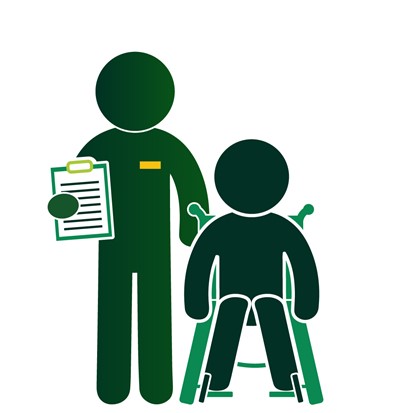
The NDIS provides funding to people with a permanent and significant disability. It helps them to access the supports and services they need to live and enjoy their life.
Each NDIS participant has a plan that lists what they want to achieve, the supports they will use and the funding they receive.
NDIS participants can choose which NDIS services provide them with support to help them reach their goals.
NDIS providers, including services-for-one
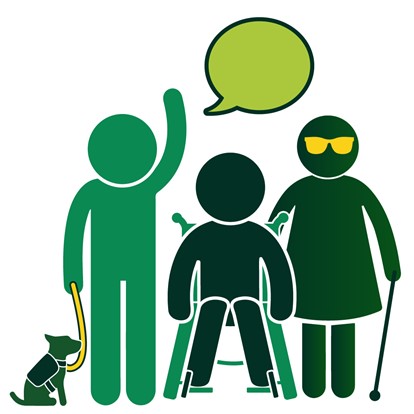
Providers deliver supports and services that help participants achieve their goals.
Providers are either registered with the NDIS Commission or unregistered.
Unregistered providers do not have to go through audits. But they still have to follow the NDIS Code of Conduct and NDIS complaints processes.
Unregistered providers can only support participants that use a Plan Manager or who self-manage.
If a provider is supporting participants with restrictive practices or living in Specialist Disability Accommodation, then they must be registered with the NDIS Commission.
Registered providers must show that they meet the quality and safety requirements for the type of supports they provide. These requirements are in the NDIS Practice Standards.
National Disability Insurance Agency (NDIA)

The NDIA is responsible for:
- approving participant plans
- deciding on participant funding
- setting the price for supports.
The NDIS Commission

The NDIS Quality and Safeguards Commission (NDIS Commission) is an independent agency set up by the government to improve the quality and safety of NDIS supports and services.
The NDIS Commission regulates and monitors NDIS providers and handles complaints about the quality and safety of NDIS supports and services. It does this for all NDIS participants. The NDIS Commission is also responsible for the registration and regulation of providers.
Approved Quality Auditors
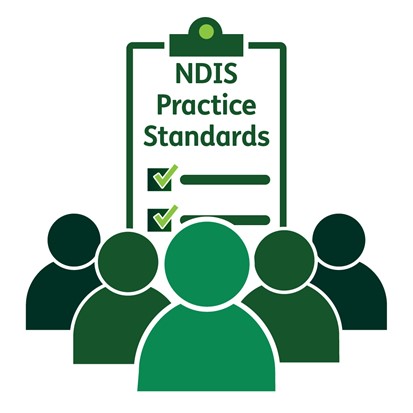
An Approved Quality Auditor is an organisation that runs audits of NDIS providers. They are independent from government, the NDIS and the NDIS Commission and make sure providers are meeting the NDIS Practice Standards.
What is a service-for-one?
Funding through the NDIS makes it easier for people with disability and families to set up supports in a way that works best for them.
A service-for-one means that you employ staff directly to support a person with disability using their NDIS funding. In a service-for-one, you employ and manage staff yourself instead of through a service provider. You can do this as a family, an individual or with other important people in the person’s life.
If you are directly employing staff, it also means that you are responsible for your own business processes, including payroll, human resources and risk management. You will need to have an Australian Business Number (ABN).
Often services-for-one are set up by families to provide support for people with complex behaviour support needs. This may be the best solution when other service models have not worked or are available.
Are you delivering a service-for-one?
How can you know if the arrangement you have in place for your family member is a service-for-one? The flow chart and examples below will help you to understand if you are delivering a service-for-one.
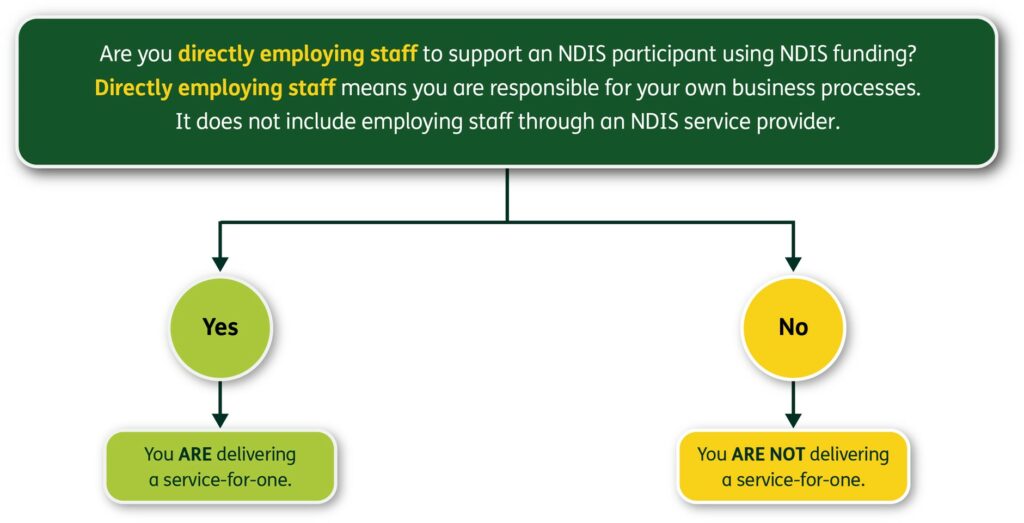
Example – Delivering a service-for-one
Ellen self-manages her son Michael’s NDIS plan. She directly employs two support workers to work with him every day. She employs an accountant using NDIS funding to do the payroll. She has set up a board with three close family friends that meet monthly to make sure the arrangement runs smoothly. Ellen is delivering a service-for-one.
Example – Not delivering a service-for-one
Darren’s parents, Holly and John, self-manage his NDIS plan. Darren, Holly and John choose their own support workers and the labour-hire agency employs the staff. The labour-hire agency manages payroll and superannuation. The support workers must follow the agency’s policies and procedures. Darren’s parents are not delivering a service-for-one.
Benefits of services-for-one
There are many benefits of providing support through a service-for-one, including:
- being supported in a way that best suits a person’s needs
- having opportunities for creativity that may not be available in larger services
- being in control of the way services are provided
- being away from people or environments that can cause the person distress or trauma
- having options for support where access to services is limited
- having more flexibility in the use of the funds in the person’s plan
- the lack of competing demands leads to greater ability to apply the supports in a more individualised way
- a better quality of life for the person with disability because their services are completely individualised.
Which services need to register with the NDIS Commission?
Not all services-for-one need to register with the NDIS Commission. Whether you need to register or not depends on the types of supports and services you provide and how a participant chooses to manage their NDIS plan.
Any NDIS provider, including services-for-one, must register with the NDIS Commission if:
- they are providing services to NDIS participants whose funding is managed by the NDIA
- they provide Specialist Disability Accommodation (SDA)
- they use regulated restrictive practices on a short or long-term basis
- they develop behaviour support plans.
This is described in subsection 33 (6) of the NDIS Act.
Do you need to register with the NDIS Commission?
The flow chart below will help you to understand if you need to register with the NDIS Commission.
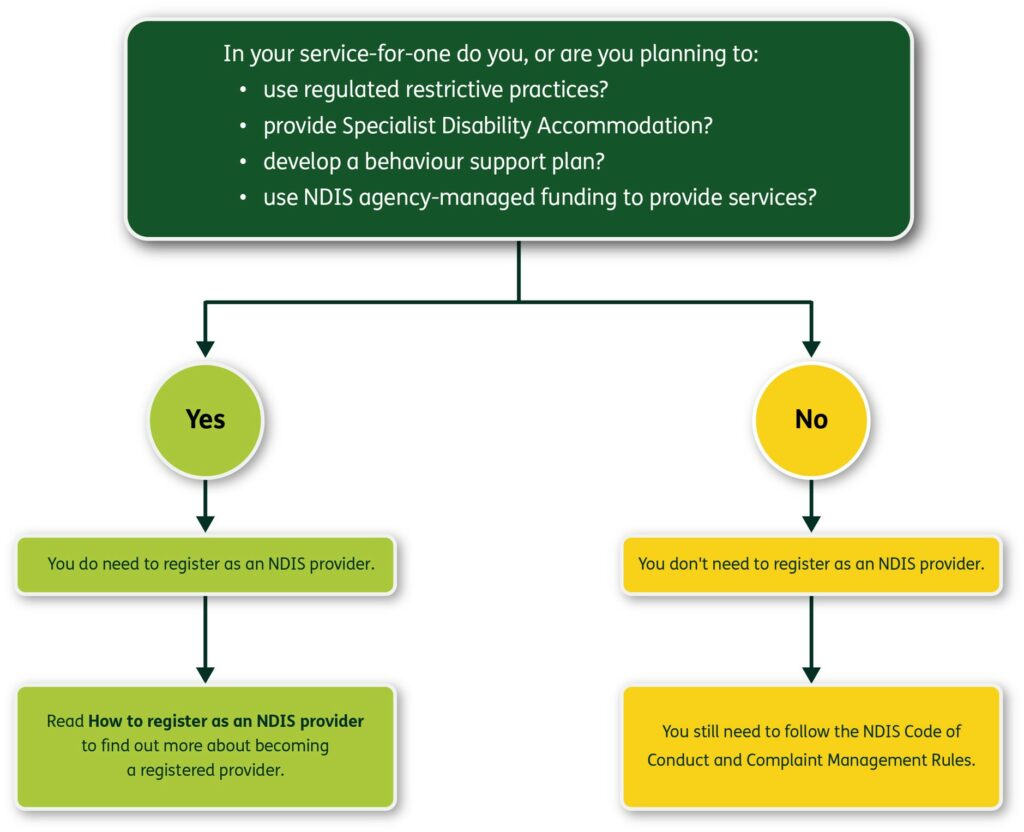
Do you need to register?
- Do you employ workers directly?
- Do they need to use restrictive practices as part of a behaviour support plant?
If you answered yes to both of these questions, you are considered to be an implementing provider and will need to register with the NDIS Commission.
If you are not sure whether you are using a regulated restrictive practice, we explain what these are in this guide.
What if you do not want to register with the NDIS Commission?
Providing support to a family member in a service-for-one can be of great benefit to the person and can allow for creative and flexible support. If you need to register as an NDIS service provider, however, the requirements can be time consuming. The initial registration process can be particularly complex to work through.
If you are running a service-for-one and using regulated restrictive practices, but do not want to register, there may be other options you can choose.
Option 1 – Removing regulated restrictive practices
You may be able to work with the NDIS Commission and NDIS behaviour support practitioners to look at ways that any restrictive practices you use could be removed. If you can safely remove restrictions by putting other strategies in place, you will not need to register.
There are many reasons why people use restrictive practices and will need to continue using them. Removing them may not be possible or safe, and this is OK. Being registered with the NDIS Commission gives you access to resources and support to help you use restrictive practices safely, as well as to reduce restrictions where possible.
Option 2 – Using a registered service provider or labour hire agency
Other people and families may choose to employ staff through a registered service provider or labour hire service instead of directly employing staff themselves. In this case, the service provider or labour hire service would be responsible for being registered with the NDIS Commission. Workers may also be registered directly as NDIS providers.
This is not possible for all families, especially in regional or remote areas or where there are not many service providers available. If you do still need to register as an NDIS provider, this set of guides will help you understand and prepare for NDIS registration. See What do you have to do as an NDIS registered provider? and How do you register as an NDIS provider?
What are regulated restrictive practices?
Many services-for-one support that family members use regulated restrictive practices as part of a behaviour support plan. A restrictive practice is any practice or intervention that restricts the rights or freedom of movement of a person with disability.
The NDIS Commission regulates the use of five types of restrictive practice. This means that these practices can only be used in ways that meet the standards set by the NDIS Commission. They can only be used as part of an authorised behaviour support plan and their use must be reported to the NDIS Commission.
The regulated restrictive practices are:
- chemical restraint
- environmental restraint
- mechanical restraint
- physical restraint
- seclusion.
We explain these in more detail below.
You must follow the NDIS Commission’s standards when using regulated restrictive practices as part of NDIS-funded supports and services. This includes when support workers use restrictive practices. It also includes a family member using restrictive practices while in their capacity as a support worker providing NDIS supports and services.
The NDIS Commission does not regulate restrictive practices that are used outside of NDIS-funded supports or services.
Authorisation of restrictive practices
The NDIS Commission monitors the use of restrictive practices by NDIS providers in Australia. Authorising restrictive practices is the responsibility of each state and territory government.
Each state and territory has their own way of authorising restrictive practices. If you become an NDIS-registered provider, you will need to know how to apply for authorisation in your state or territory. You will need to make sure that any restrictive practice you use is authorised according to the processes in your state or territory.
For more information on the authorisation process:
- in Victoria: Department of Families, Fairness and Housing
- in Queensland: Department of Communities, Disability Services and Seniors
- in New South Wales: Department of Communities and Justice
- in South Australia: Department of Human Services
- in Northern Territory: Department of Health
- in Western Australia: Department of Communities
- in Tasmania: Department of Communities
- in Australian Capital Territory: Community Services.
How do you know if your service-for-one uses a regulated restrictive practice?
If the person you are supporting has a behaviour support plan, it must describe any regulated restrictive practices that are being used. If you do not have a behaviour support plan, the NDIS Commission has information on its website that can help you decide if you need one.
You can find detailed information about regulated restrictive practices in the NDIS Commission’s Regulated Restrictive Practices Guide. This includes decision trees that can help you understand if what you are doing is a restrictive practice. The information below is from the NDIS Commission’s guide.
The five types of regulated restrictive practices
Chemical restraint
Chemical restraint, under the NDIS (Restrictive Practices and Behaviour Support) Rules, is:
“…the use of medication or chemical substance for the primary purpose of influencing a person’s behaviour. It does not include the use of medication prescribed by a medical practitioner for the treatment of, or to enable treatment of, a diagnosed mental disorder, a physical illness or a physical condition.”
This means that chemical restraint is when you use medication or chemicals to change a person’s behaviour.
For example: Medication to reduce agitation or self-harm, which is not to do with a physical or mental health condition, would be a chemical restraint.
Chemical restraints do not include medication that a doctor prescribes to treat, or to help treat:
- a diagnosed mental disorder
- a physical illness
- a physical condition.
For example: Diazepam prescribed as a muscle relaxant to use after a seizure is not a chemical restraint. This is because the main purpose of the medication is to treat a physical condition.
You can find more information about chemical restraint on pages 9–13 of the NDIS Commission’s Regulated Restrictive Practices Guide.
You can also contact the Behaviour Support team in your state or territory for specific advice.
Environmental restraint
Environmental restraint, under the NDIS (Restrictive Practices and Behaviour Support) Rules:
“…restricts a person’s free access to all parts of their environment, including items or activities.”
This means that an environmental restraint restricts a person’s access to things and spaces around them. This includes items they might want and activities they want to do.
For example:
- Locking a door, cupboard or fridge to stop a person from opening them.
- Stopping a person from doing activities or using things like a mobile phone.
- Limiting a person’s access to dangerous things like sharp objects that could be used to self-harm.
Environmental restraints do not include general safety measures like locking the front door at night for safety – as long as the person is still able to leave their home if they choose to. They also do not include things like locking away medication.
You can read more about environmental restraint on pages 14–16 of the NDIS Commission’s Regulated Restrictive Practices Guide.
You can also contact the Behaviour Support team in your state or territory for specific advice.
Mechanical restraint
Mechanical restraint, under the NDIS (Restrictive Practices and Behaviour Support) Rules is:
“…the use of a device to prevent, restrict, or subdue a person’s movement for the primary purpose of influencing a person’s behaviour but does not include the use of devices for therapeutic or non-behavioural purpose”.
This means that mechanical restraint is when you use a device to stop, restrict or contain someone’s movement to change their behaviour. Mechanical restraint may be used to stop someone from self-harming like:
- head butting
- pulling out hair
- hand biting
- skin picking.
Things that can be used as mechanical restraint might include:
- splints
- gloves
- a helmet.
Mechanical restraint does not include the use of devices for therapy or non-behavioural reasons.
Deciding if a device is a mechanical restraint or not also depends on how it is used.
For example: A seatbelt guard is not considered a mechanical restraint if you need to use it while travelling from one place to another. It is considered a mechanical restraint if you leave the guard in place to keep the person in the car when the car is parked.
You can find more information about mechanical restraints on pages 9–13 of the NDIS Commission’s Regulated Restrictive Practices Guide.
You can also contact the Behaviour Support team in your state or territory for specific advice.
Physical restraint
Physical restraint, under the NDIS (Restrictive Practices and Behaviour Support) Rules, is:
“…the use or action of physical force to prevent, restrict or subdue movement of a person’s body, or part of their body, for the primary purpose of influencing their behaviour. Physical restraint does not include the use of a hands-on technique in a reflexive way to guide or redirect a person away from potential harm/injury, consistent with what could reasonably be considered the exercise of care towards a person.”
This means physical restraint is when you use physical force to stop, restrict or contain someone’s body, or part of their body, from moving to change their behaviour.
For example: Holding a person’s hand down to stop them from hitting themselves is physical restraint.
Physical restraint does not include putting your hands on a person to support them to complete a task or guide them away from possible harm or injury.
However, it is considered physical restraint if force is used.
You can find more information about physical restraint on pages 21–25 of the NDIS Commission’s Regulated Restrictive Practices Guide.
You can also contact the Behaviour Support team in your state or territory for specific advice.
Seclusion
Seclusion, under the NDIS (Restrictive Practices and Behaviour Support) Rules, is:
“The sole confinement of a person with disability in a room or a physical space at any hour of the day or night where voluntary exit is prevented, or not facilitated, or it is implied that voluntary exit is not permitted.”
This means seclusion is when a person with disability is confined in a room or a space on their own. It includes any hour of the day or night where the person cannot leave the space. The person may:
- be stopped from leaving the space
- not be given any help to leave
- believe they are not allowed to leave.
This includestime out alone in a room or area where the person cannot leave or believes they cannot leave.
It is not considered seclusion if a person chooses to go to their room and lock the door for their own privacy, as long as they are free to leave at any time.
You can find more information about seclusion on pages 26–29 of the NDIS Commission’s Regulated Restrictive Practices Guide.
You can also contact the Behaviour Support team in your state or territory for specific advice.
What’s next?
If you have decided that you are a service-for-one that uses regulated restrictive practices and that you will need to register with the NDIS Commission, you can read more about registration requirements in What do you have to do as an NDIS registered provider?
Contact details for the NDIS Commission
Registration: If you have any specific questions about NDIS registration contact the NDIS Commission on 1800 035 544, or via email [email protected].
Behaviour Support: Contact the NDIS Quality and Safeguards Commission
Website: www.ndiscommission.gov.au/providers/behaviour-support
Phone: 1800 035 544 (Monday to Friday, excluding public holidays)
- 9:00am–4:30pm in the Northern Territory
- 9:00am–5:00pm in the Australian Capital Territory, Queensland, South Australia, Tasmania, Victoria and Western Australia
Email: [email protected]
References
NDIS Quality and Safeguards Commission (2020). ‘Regulated Restrictive Practices Guide’. Penrith, Australia: NDIS Quality and Safeguards Commission.
NDIS Commission – Unauthorised use of restrictive practices questions and answers
